MV Taka, Solomon IslandsContents of this Issue: Deadman Diving – Whatever Next? Your Battery Charger: a Real Risk of Liveaboard Fire Nicaragua, Lembeh, Thailand, Florida, Socorro Will East Timor Become a Popular Diving Destination? Plastic? Some Dive Operators Step Up Undercurrent Subscribers Set a Guinness Record: The Oldest Couple Diving Ghost Net Massacres, Cayman Marine Life Still Trouble with Full-Face Snorkeling Masks? A Retired Mares Dealer Makes His Reservations Clear Are Underwater Photography Courses Good Value? We Want To Hear From You A Real Advanced Open Water Class No Safety Sausage? Toss Water! Things Are Not Always As They Seem The End of American Abalone Diving? Editorial Office: Ben Davison Publisher and Editor Undercurrent 3020 Bridgeway, Suite 102 Sausalito, CA 94965 and a word about the Bilikiki from the May, 2018 issue of Undercurrent
Dear Fellow Diver,
Booking a month before departure, I contacted both SIDE and the Master group, and Shaz got right back and told me to book with her. I did, but I waited and waited for confirmation and payment instructions, and without my perseverance, I am unsure I would have completed the booking. As it turned out, Shaz was on the Taka and couldn't respond until she had a satellite connection (the boat has no internet or satellite link and spotty local cell service) and the office, too, had fallen short. After I retrieved my bags in the Solomons' airport, a Taka representative crammed all the other divers who were on my flight into his ratty old van and headed to town through dust clouds and traffic. Though Honiara is the gateway to Guadalcanal, it has, at best, a limited tourist infrastructure. We were dropped at an air-conditioned sushi café, where I longingly looked out the window at the Taka as the crew readied the boat for our journey. It would be six hours before we were permitted to board. My first impression of the boat was "this is not too bad." The dive deck was spacious, the main salon looked cozy, and my buddy and I had been upgraded to the master cabin. Before we could settle in, we were summoned by the cruise directors (Adam, an aspiring English photographer who plugged his work throughout the cruise, and Carmen, an excitable young Romanian environmentalist), for a muster station drill wearing our life jackets. Afterward, we were briefed in the lounge, sat down to dinner, then showed c-cards, signed waivers, and listened to an extended orientation, while the boat departed for its six-hour journey.
The next morning, I jumped off the stern at Coral Garden into calm water and spectacular visibility. Parrotfish displayed their full-color spectrum, and clownfish were common. Sea fans, as tall as I am, ran from the surface to as deep as one dared to dive, while thick swarms of fusiliers flitted about the reef tops, among layers and layers of hard coral. Though the soft coral population is much less than, say, Raja Ampat, could it be that reefs here were in better shape? The Solomons do not have the biodiversity of Indonesia, but there were no bombed-out reefs.
Although we did not begin to touch on all the spectacular sites that the Bilikiki had offered on my past trips, the Taka crew made sure we dived the cave systems at the optimum times to take advantage of the light rays shimmering through the rock formations. At Munda, we descended to a wall and gently floated along until we reached a manta cleaning station, where we watched as many as eight giant black mantas circle. We nine divers (two others aboard were snorkelers) dived in two groups, each with rotating guides. We would either leap from the Taka (my camera gear was always handed down with the utmost care) or dive from the two 14-foot (4.2m) rigid hull inflatable (RIB) tenders. For those who had a hard time climbing back in the RIBs after a 60- to 70-minute dive (the RIBS were so underflated, the ladders were useless), the driver simply towed them back.
Meals were good, some buffet, some served. Before the first dive each day, it was toast, homemade muffins, cereals and fruit, sweet condensed juices and bitter coffee. The main breakfast was eggs with bacon, sausage, and sometimes baked beans, pancakes, or French toast. For lunch it would be homemade pizza, hamburgers, French fries and coleslaw, fresh fish and veggies. A typical dinner might be a choice of roast lamb or chicken, accompanied by homemade bread, green beans, Chinese water cabbage, mashed potatoes, and a green salad. Another night we had a barbeque on the deck. Our seasonal repeats were pumpkin squash, watermelon, bananas, and papaya. I would have liked more homemade desserts. The chefs took such pride that they were disappointed when I asked for half portions. Between-meal snacks -- homemade biscuits or cookies, cheese and crackers, nut-free brownies for me due to a food allergy) -- were plentiful. The chefs would constantly check about my food allergies and the cruise directors even wanted to know where I kept my Epipen. When I was on the Bilikiki, they frequently bought produce from locals who had paddled out in dugouts with their children. It was great fun to see the rows and rows of dugouts and the colorful villagers. I missed this great cultural show on the Taka, which only once brought out the villagers.
During the cruise, the men in the all-Solomons crew hung out on the bow, frequently smoking, while the women stayed near the dive deck, tending to the washer and dryer. One kind woman frequently hugged me, showing her sincere appreciation for having me as a guest. Why me, I don't know, but she helped make me feel like family. Having an upper cabin with a head is the only way to go, though our head was tiny, with a sink too small to wash my hands. I had a full-sized bed with half a twin couch. Our wardrobe was too small to handle two adults' clothing. Below decks, cabins have no bathrooms and occupants must walk upstairs and through the salon to the shared bathroom/shower combos on the dive deck. While the boat sleeps 24, it would be too crowded for me if it were fully booked. One of my favorite dives began with an entry from the unmoored Taka. After retrieving my camera from a crewmember, I met three other divers, and we went down to dive our individual profiles while keeping an eye on the others. The reef was covered with gorgonian sea fans and whips, and barrel sponges bigger than midsize cars. The water was clear and 87°F (31°C). Cruising along at 40 feet (12m), I could see the other group 100 feet (30m) deep. A reef shark and a few turtles passed by between us. Fish numbers were overwhelming around this undamaged, pristine reef. I descended to shoot my buddies in silhouette above massive red sea fans, with the shimmering sunlight the perfect backdrop. Finally, we swam into the blue for our three-minute safety stop. On the surface, I handed my camera to the tender driver and swam the short distance to the waiting Taka. On board, I jumped into the hot shower to rinse my wetsuit, since the rinse bucket smelled of urine. Justin poured in some disinfectant. I off-gassed while eating fresh-baked scones. We eleven guests were from the U.S., Australia, England, Bermuda and Poland (where it seems deodorant isn't sold), and, as is the case aboard liveaboards, we had plenty of great conversations. However, the boat is loud, as the main airflow vents on the upper deck ran constantly. I found myself shouting to have a conversation in the uncovered lounge area under the blistering sun. Annoying. This was cyclone season, and though the storms skirted the edge of the Solomons both before and after my trip, we had calm seas. (Two years before, the Bilikiki lost its only engine and was adrift for hours at night in big swells.) The water was 86- 90°F (29-32°C), the same as the air. My previous trips -- one in July and one in October -- saw water 79-84°F (21-29°C), limited visibility, and many rainy days. One drawback to cyclone season is the ubiquitous flies, which I had to constantly brush away.
The dive crew set recreational limits (130 feet (40m) on air, 121 feet (36m) on nitrox) and many divers dived to those limits. But, why push limits on a multiple-day dive trip with a chamber hours away in Honiara, run by volunteers? Real medical care is in Australia, three hours by commercial flight, or $50K for private evacuation. A few guests ask why my buddy and I dived no deeper than 70 feet (21m). Had I been bent? No, I just dive smart. Having been trained in hyperbaric medicine, there is no way I want to be the patient. Why go deep and miss out on the great colors? What is it you hope to see down there? Why put your and everyone's dive trip at risk? For photographers, a real downside of the Taka is that it is without a camera room or even designated charging stations, so the crew suggested I charge my lights in my cabin. However, when I plugged in my multi-charger, it smoked and sparked. It was a good thing I was there to disconnect it. The boat crew joked about the spotty Solomon electricians and gave me another charging strip. Taka offered three to four dives per day, with two village visits (only one of which was a wood-carving visit), while my trip on the Bilikiki had four to five dives a day with four wood-carving visits and two to three separate village tours. The island people are unique, their villages fascinating, their intricate wood carvings beautiful (many with an underwater theme). After I voiced my disappointment, the cruise directors said they could perhaps invite a carver aboard, but it never happened. The Taka will be traveling the reefs of PNG a few months of the year, and both cruise directors said they will be moving on to new assignments. It's a toss-up as to what liveaboard I would dive with next time, but, indeed, I will return. The Bilikiki has a huge number of repeat customers, caters to senior divers with easy diving, choosing sites with minimal current, and offers one more dive a day. Generally, it offers a better experience. But the boat is old and outdated, with all the cabins below decks, though with en-suite heads. The Taka is a fresh option, with better food, better cabins -- if you have a head -- and a slightly lower price. Both chose amazing sites, but the Bilikiki added more WWII wrecks to the itinerary (the Taka dives two) while moving often during the day. Typically, the Taka would settle in for the day, diving some sites two or three times. Had the visibility not been so wonderful, it might have become boring, but not enough to keep me away. I'll be back. --BH P.S. Malaria is a serious risk in the Solomons, and not one I would take. So, I was surprised that many guests were not taking a recommended prophylaxis, such as Atovaquone-proguanil (Malarone) or Doxycycline (with a side-effect of increased sensitivity to sunshine). Chloroquine is ineffective. Mefloquine (Larium) should not be used if diving, thanks to possible nervous system side-effects (hallucinations). Our Undercover Diver's Bio: Part mermaid, and certified in the 80s, by a memorable instructor at a local community college, and inspired to become a scuba instructor, which I did in Hawaii where diving logging ceased. Diving whenever and wherever I can is life's motto, as long as the water is above 80ºF. I've been to Australia, Micronesia Fiji, PNG, Indonesia, the Maldives, the list goes on. In retirement, you'll find me working in the industry, trying to recoup the thousands I have spent on these dive trips..
|

I want to get all the stories! Tell me how I can become an Undercurrent Online Member and get online access to all the articles of Undercurrent as well as thousands of first hand reports on dive operations world-wide
| Home | Online Members Area | My Account |
Login
|
Join
|
| Travel Index |
Dive Resort & Liveaboard Reviews
|
Featured Reports
|
Recent
Issues
|
Back Issues
|
|
Dive Gear
Index
|
Health/Safety Index
|
Environment & Misc.
Index
|
Seasonal Planner
|
Blogs
|
Free Articles
|
Book Picks
|
News
|
|
Special Offers
|
RSS
|
FAQ
|
About Us
|
Contact Us
|
Links
|
3020 Bridgeway, Ste 102, Sausalito, Ca 94965
All rights reserved.

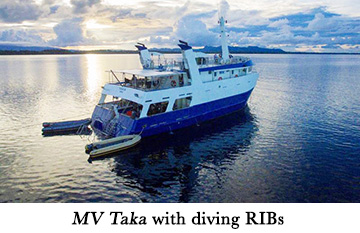 Having dived the Solomon Islands twice on the Bilikiki, I returned in February, this time to join the MV Taka, a newer boat with a different itinerary. The Taka (otherwise known as the PNG/Solomon Master), is owned by an Australian, operated by the Solomon Islands Dive Expeditions (that is, a Canadian, Shannon "Shaz" Kozak), and marketed by the Master Liveaboard Group. If this sounds confusing, it is, and so was booking the trip.
Having dived the Solomon Islands twice on the Bilikiki, I returned in February, this time to join the MV Taka, a newer boat with a different itinerary. The Taka (otherwise known as the PNG/Solomon Master), is owned by an Australian, operated by the Solomon Islands Dive Expeditions (that is, a Canadian, Shannon "Shaz" Kozak), and marketed by the Master Liveaboard Group. If this sounds confusing, it is, and so was booking the trip.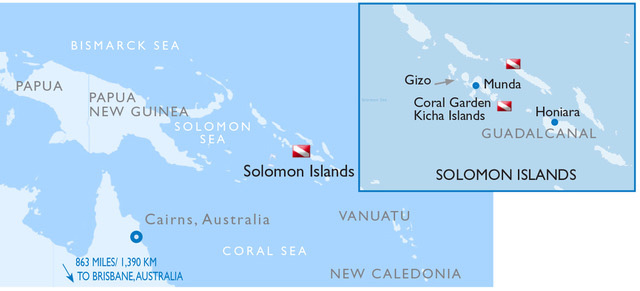
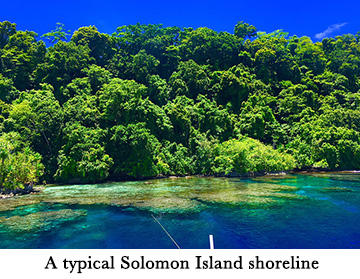 Diving was easy and relaxing, though currents can occasionally pick up and rip. In some areas, topography is so unusual that one could get lost in the labyrinth of tunnels, canyons, caves and lava tubes. Unfortunately, the Taka did not offer many of these fantastic maze dives, as the crew simply did not know how to navigate them. They can be dangerous, and one can get lost, as I did at Cathedrals. Lagging behind the group to shoot photos, I found myself alone in a cave system, no bubbles anywhere, and totally disoriented. Even though I have been diving 30 years, I still get claustrophobic if I can't see daylight above. After 10 minutes, I finally made my way out, where a six-foot black tip reef shark greeted me before I met my group.
Diving was easy and relaxing, though currents can occasionally pick up and rip. In some areas, topography is so unusual that one could get lost in the labyrinth of tunnels, canyons, caves and lava tubes. Unfortunately, the Taka did not offer many of these fantastic maze dives, as the crew simply did not know how to navigate them. They can be dangerous, and one can get lost, as I did at Cathedrals. Lagging behind the group to shoot photos, I found myself alone in a cave system, no bubbles anywhere, and totally disoriented. Even though I have been diving 30 years, I still get claustrophobic if I can't see daylight above. After 10 minutes, I finally made my way out, where a six-foot black tip reef shark greeted me before I met my group.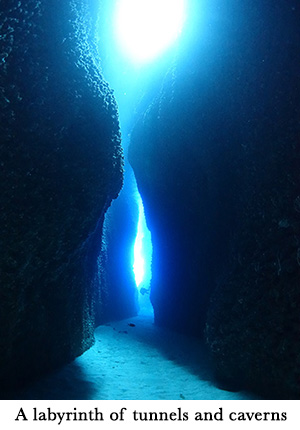 I made every night dive, though a bit apprehensively, since the number one predator in the Solomons is saltwater crocodiles. Mirror Pond is the home of "Tracy," a croc the locals are waiting to capture as soon as she hits the 12-foot (4m) mark. We back-rolled in at Karamulon Point, near Mirror Pond, and headed straight down to avoid Tracy and any of her mates after our tender driver scanned the shoreline. At 20 feet (6m), we were on the hunt for unusual macro and quickly found the famous marbled shrimp and basket star shrimp, though my mind was on Tracy. (You see, on a Bilikiki dive here two years ago, when we surprised her with our bubbles, she came toward us before veering away.) We climbed on the bouncy tender and headed way back to the Taka, with phosphorescence glowing in our wake under the starry night sky, after 45 minutes of viewing a myriad of macro (shrimp, nudi's, juvenile wrasse, and the swarms of worms attracted to the lights). Although the water was 85°F (29°C), back on the boat, I gratefully accepted hot cocoa and a warm towel. My buddy swore he could see Tracy on the shoreline, her red, beady eyes staring back.
I made every night dive, though a bit apprehensively, since the number one predator in the Solomons is saltwater crocodiles. Mirror Pond is the home of "Tracy," a croc the locals are waiting to capture as soon as she hits the 12-foot (4m) mark. We back-rolled in at Karamulon Point, near Mirror Pond, and headed straight down to avoid Tracy and any of her mates after our tender driver scanned the shoreline. At 20 feet (6m), we were on the hunt for unusual macro and quickly found the famous marbled shrimp and basket star shrimp, though my mind was on Tracy. (You see, on a Bilikiki dive here two years ago, when we surprised her with our bubbles, she came toward us before veering away.) We climbed on the bouncy tender and headed way back to the Taka, with phosphorescence glowing in our wake under the starry night sky, after 45 minutes of viewing a myriad of macro (shrimp, nudi's, juvenile wrasse, and the swarms of worms attracted to the lights). Although the water was 85°F (29°C), back on the boat, I gratefully accepted hot cocoa and a warm towel. My buddy swore he could see Tracy on the shoreline, her red, beady eyes staring back.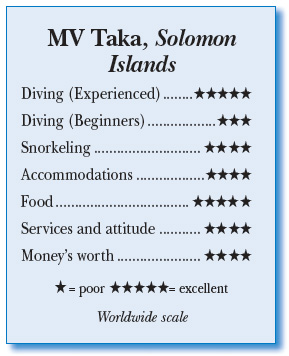 One night after dinner aboard the Taka, the
crew threw scraps overboard, attracting frenzied
sharks to entertain the guests. Once Carmen discovered
this, she yelled at the crew to stop,
saying "no shark feeding, we talked about this,
you promised." I felt like a child who had been
caught doing something naughty, when in fact
I saw nothing wrong with an innocent activity.
Awfully extreme, I think.
One night after dinner aboard the Taka, the
crew threw scraps overboard, attracting frenzied
sharks to entertain the guests. Once Carmen discovered
this, she yelled at the crew to stop,
saying "no shark feeding, we talked about this,
you promised." I felt like a child who had been
caught doing something naughty, when in fact
I saw nothing wrong with an innocent activity.
Awfully extreme, I think.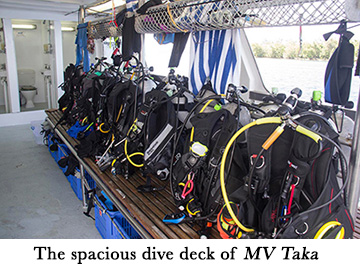 Mary's is one of my favorite dive spots, so I put in a request. Because mooring is tricky -- the wind can blow the boat ashore -- they were reluctant to go, but agreed (Adam made it clear how lucky we were). It has much diversity, great night diving, reliable schools of jacks, barracudas, bump heads, and at times, a manta or reef shark. Two years ago, the coral was covered in algae and crowns of thorns, but it had made an amazing recovery. What crowns of thorns we did see, we gently picked them up and dropped them off into deep water.
Mary's is one of my favorite dive spots, so I put in a request. Because mooring is tricky -- the wind can blow the boat ashore -- they were reluctant to go, but agreed (Adam made it clear how lucky we were). It has much diversity, great night diving, reliable schools of jacks, barracudas, bump heads, and at times, a manta or reef shark. Two years ago, the coral was covered in algae and crowns of thorns, but it had made an amazing recovery. What crowns of thorns we did see, we gently picked them up and dropped them off into deep water. Divers Compass: On our last day, we were required to disembark at 8:00 a.m., five hours before the 1:00 p.m. flight, meaning you sit at the airport if you opted out of a tour ... One gets to the Solomons through either Fiji or Brisbane, Australia. (The Bilikiki website show flights.) ... Staying overnight in Honiara (it's a rough industrial town) in the older, established hotels runs $150 and up. The Coral Sea is a new hotel ... I flew Air Niugini, which had an extra 10 kg. diver's baggage allowance ... Fiji Airways charges $150 for the second bag ... I took advantage of Taka's last-minute special, $1000 off regular pricing and free nitrox (I have never seen the Bilikiki reduce their rates) ... Adam, who dived with twin 80s, created a video that he sold at the end of the trip ... Bring all your gear although rental gear did seem reliable. Tanks were 110s, 80s, even smaller ... On the way from the airport, ask your driver to stop so you can exchange cash at a "money changer." ATMs don't always work and may limit the amount. To buy wood carvings, you will need local currency.
Divers Compass: On our last day, we were required to disembark at 8:00 a.m., five hours before the 1:00 p.m. flight, meaning you sit at the airport if you opted out of a tour ... One gets to the Solomons through either Fiji or Brisbane, Australia. (The Bilikiki website show flights.) ... Staying overnight in Honiara (it's a rough industrial town) in the older, established hotels runs $150 and up. The Coral Sea is a new hotel ... I flew Air Niugini, which had an extra 10 kg. diver's baggage allowance ... Fiji Airways charges $150 for the second bag ... I took advantage of Taka's last-minute special, $1000 off regular pricing and free nitrox (I have never seen the Bilikiki reduce their rates) ... Adam, who dived with twin 80s, created a video that he sold at the end of the trip ... Bring all your gear although rental gear did seem reliable. Tanks were 110s, 80s, even smaller ... On the way from the airport, ask your driver to stop so you can exchange cash at a "money changer." ATMs don't always work and may limit the amount. To buy wood carvings, you will need local currency.